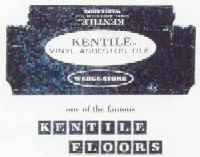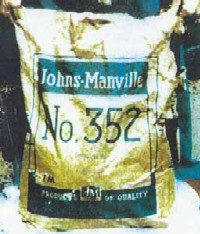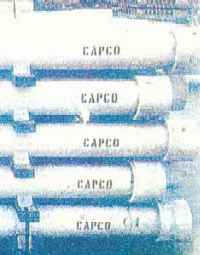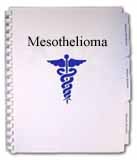Types of Lung Cancer
Asbestos Lung Cancer
Asbestos Background and Use
Asbestos is a mineral that is mined much like other minerals,
such as iron, lead, and copper, are. There are many varieties of
asbestos: the three most common are chrysotile
asbestos, amosite
asbestos, and crocidolite
asbestos.
Unlike most minerals, which turn into dust particles when crushed,
asbestos breaks up into fine fibers that are too small to be seen
by the human eye. Often, individual asbestos fibers are mixed with a material
that binds them together, producing an asbestos containing material
(ACM).
 Asbestos was first used in the United States in the early
1900's, to insulate steam engines. After World War II, and for the
next thirty years, people who constructed and renovated schools
and other public buildings used asbestos and asbestos-containing
materials (ACM) extensively. ACM's were used primarily to fireproof,
insulate, soundproof, and decorate buildings. The Environmental
Protection Agency (EPA) estimates there are ACM's in most of the
nation's approximately 107,000 primary and secondary schools, and
733,000 public and commercial buildings. Asbestos was first used in the United States in the early
1900's, to insulate steam engines. After World War II, and for the
next thirty years, people who constructed and renovated schools
and other public buildings used asbestos and asbestos-containing
materials (ACM) extensively. ACM's were used primarily to fireproof,
insulate, soundproof, and decorate buildings. The Environmental
Protection Agency (EPA) estimates there are ACM's in most of the
nation's approximately 107,000 primary and secondary schools, and
733,000 public and commercial buildings.
 One study estimated that
3,000 different types of commercial products once contained asbestos.
The amount of asbestos in each product varied from as little as
one percent to as much as 100 percent. Many older plastics, paper
products, brake linings, floor tiles and textile products contain
asbestos; as do many heavy industrial products such as sealants,
cement pipe, cement sheets, and insulation. The law now prohibits
the manufacture, processing, and importation of most asbestos products in the United States. One study estimated that
3,000 different types of commercial products once contained asbestos.
The amount of asbestos in each product varied from as little as
one percent to as much as 100 percent. Many older plastics, paper
products, brake linings, floor tiles and textile products contain
asbestos; as do many heavy industrial products such as sealants,
cement pipe, cement sheets, and insulation. The law now prohibits
the manufacture, processing, and importation of most asbestos products in the United States.
 Manufacturers and builders found asbestos useful for a variety
of reasons. It is strong yet flexible, and it will not burn. It
conducts electricity poorly, and insulates effectively. Asbestos also
resists corrosion. Few other available substances have all of these
qualities. Manufacturers and builders found asbestos useful for a variety
of reasons. It is strong yet flexible, and it will not burn. It
conducts electricity poorly, and insulates effectively. Asbestos also
resists corrosion. Few other available substances have all of these
qualities.
When asbestos fibers are in the air, people may inhale them. Because
asbestos fibers are small and light, they can stay in the air for
a long time, and are not easily detected. People whose work brings
them into contact with asbestos -- workers who renovate buildings
with asbestos in them, for example -- may inhale fibers that are
in the air and this is called occupational asbestos exposure. Workers' families
may inhale asbestos fibers released by clothes that have been in
contact with ACM and this is called paraoccupational exposure to asbestos.
 People
who live or work near asbestos- related operations may inhale asbestos
fibers that have been released into the air by the operations and this
is called neighborhood exposure. Those who are downwind from an asbestos plant could be at risk even many miles away if the fibers can be blown on the wind to their area. People
who live or work near asbestos- related operations may inhale asbestos
fibers that have been released into the air by the operations and this
is called neighborhood exposure. Those who are downwind from an asbestos plant could be at risk even many miles away if the fibers can be blown on the wind to their area.
|

































 Asbestos was first used in the United States in the early
1900's, to insulate steam engines. After World War II, and for the
next thirty years, people who constructed and renovated schools
and other public buildings used asbestos and asbestos-containing
materials (ACM) extensively. ACM's were used primarily to fireproof,
insulate, soundproof, and decorate buildings. The Environmental
Protection Agency (EPA) estimates there are ACM's in most of the
nation's approximately 107,000 primary and secondary schools, and
733,000 public and commercial buildings.
Asbestos was first used in the United States in the early
1900's, to insulate steam engines. After World War II, and for the
next thirty years, people who constructed and renovated schools
and other public buildings used asbestos and asbestos-containing
materials (ACM) extensively. ACM's were used primarily to fireproof,
insulate, soundproof, and decorate buildings. The Environmental
Protection Agency (EPA) estimates there are ACM's in most of the
nation's approximately 107,000 primary and secondary schools, and
733,000 public and commercial buildings.  One study estimated that
3,000 different types of commercial products once contained asbestos.
The amount of asbestos in each product varied from as little as
one percent to as much as 100 percent. Many older plastics, paper
products, brake linings, floor tiles and textile products contain
asbestos; as do many heavy industrial products such as sealants,
cement pipe, cement sheets, and insulation. The law now prohibits
the manufacture, processing, and importation of most asbestos products in the United States.
One study estimated that
3,000 different types of commercial products once contained asbestos.
The amount of asbestos in each product varied from as little as
one percent to as much as 100 percent. Many older plastics, paper
products, brake linings, floor tiles and textile products contain
asbestos; as do many heavy industrial products such as sealants,
cement pipe, cement sheets, and insulation. The law now prohibits
the manufacture, processing, and importation of most asbestos products in the United States.
 Manufacturers and builders found asbestos useful for a variety
of reasons. It is strong yet flexible, and it will not burn. It
conducts electricity poorly, and insulates effectively. Asbestos also
resists corrosion. Few other available substances have all of these
qualities.
Manufacturers and builders found asbestos useful for a variety
of reasons. It is strong yet flexible, and it will not burn. It
conducts electricity poorly, and insulates effectively. Asbestos also
resists corrosion. Few other available substances have all of these
qualities. People
who live or work near asbestos- related operations may inhale asbestos
fibers that have been released into the air by the operations and this
is called neighborhood exposure. Those who are downwind from an asbestos plant could be at risk even many miles away if the fibers can be blown on the wind to their area.
People
who live or work near asbestos- related operations may inhale asbestos
fibers that have been released into the air by the operations and this
is called neighborhood exposure. Those who are downwind from an asbestos plant could be at risk even many miles away if the fibers can be blown on the wind to their area.